A Boom Time for Contemporary Art : Record Prices Draw Mixed Reviews From Art World
- Share via
NEW YORK — Impressionist and modern art brought in the biggest bucks, but contemporary art attracted the most attention during a week of record-setting auctions here that drew to a close late Wednesday afternoon.
“Contemporary art is no longer the stepchild of modern art. Contemporary art has become such a popular pastime that the excitement carries over from the galleries into the auction houses.” said Martha Baer, head of Christie’s contemporary art department.
Sotheby’s rang up $150 million in Impressionist and modern sales, and an additional $81 million in contemporary art during its marathon of auctions. Christie’s sold more than $159-million worth of Impressionist and modern art, plus $43 million in contemporary works.
Despite a couple of disappointing Impressionist and modern sales, final tallies exceeded all expectations and set records for both houses.
Picasso’s modern painting called “Motherhood” captured the week’s top price of $24.75 million, an auction record for 20th-Century art. But sales of contemporary paintings by Jasper Johns for $7 million one night and $17 million the next were considered even more stunning. Few had dreamed that works by a living artist--no matter how well-regarded--could earn such sums.
After selling the $17-million painting, “False Start,” to media magnate Samuel I. Newhouse Jr. (Conde Nast magazines, Random House and other holdings), Sotheby’s Chairman John L. Marion hailed the event as “a very historic evening” and “the culmination of many years of work with the contemporary market.”
Lucy Mitchell-Innes, Sotheby’s leading contemporary art expert, said, “Five years ago when we sold a Rothko for $1.8 million, I thought it would be another five years before that was repeated. How wrong I was.”
As contemporary art has assumed a much more prominent place in the market, the auction house’s contemporary art specialists have acquired a certain star status. Following the sale of “False Start,” Marion introduced Mitchell-Innes to reporters as “the genius of the contemporary market.”
Earlier, Christie’s had released a fact sheet on Martha Baer, charting a spectacular rise in contemporary sales under her direction and noting landmarks in her 10-year career at Christie’s.
The auction houses’ conspicuous role in an ongoing contemporary art boom drew mixed reviews from the audience. Dealers who once attended auctions as quiet trade conventions and picked up stock at reasonable prices generally say they have been priced out of the auction market.
So have museums and many collectors who began buying before auctions became a billionaires’ playground. One major contemporary collector, who requested anonymity, said she had already called a meeting with her attorney and insurance agent to see what precautions she should take with her collection, now that it has become a multimillion-dollar responsibility.
Los Angeles dealer Marc Richards said that highly publicized auctions may have a detrimental effect on galleries because people only read about spectacles and don’t relate that to ordinary business in galleries.
Another dealer who requested anonymity commented: “If you tried to interest some of these people in a work by a new artist for $2,000, they would walk out of your gallery.”
But Meredith Palmer, of the Herbert Palmer Gallery in Los Angeles, cited “a symbiotic relationship” between galleries and the auction market. Bids on contemporary art were triple what she wanted to pay, she said, but “a strong art market is good for everyone.”
Some observers dispute the trickle-down effect of vast sums paid for works by celebrated artists, but sales figures indicate that prices have risen across the board for contemporary works sold at auction.
Since his death, Andy Warhol’s prices have escalated sharply. His serial painting, “Marilyn Monroe (20 Times),” valued around $1.5 million, fetched $3.96 million. Jean-Michel Basquiat’s recent death also accounts for the meteoric rise in his prices--from about $20,000 to more than $100,000.
But prices for works by well-established living artists also shot up in the recent round of auctions. Tom Wesselmann’s “The Great American Nude 8,” valued around $125,000, sold for $462,000.
Christo’s mixed-media construction, “Brite Green Store Front,” doubled its estimate and sold for $214,000. George Segal’s plaster sculpture, “Self Portrait With Head and Body,” expected to bring about $150,000, fetched $242,000.
“It’s true that there are only a few million-dollar artists, but there are lots whose work sells for over $100,000 and that’s a lot of money,” Baer said.
Emotions ran high throughout the week, and many observers confessed to feeling both thrilled and disturbed by the spectacle. “When I watched bids rise by increments of $250,000 and $500,000, I couldn’t help thinking, ‘There are people out there on the streets who are starving,’ ” said one prominent collector.
Most successful bidders scrupulously guard their anonymity, either buying by telephone or through dealers sworn to secrecy. But notable exceptions lead some observers to characterize the auction process as a publicity machine.
Hans Thulin, a 40-year-old Swedish real-estate mogul, announced his debut as a major collector by buying Johns’ “White Flag” for $7 million and issued a press release indicating plans for future purchases.
Newhouse, who bought the $17-million Johns through New York dealer Larry Gagosian, “got $17-million worth of publicity and a free painting,” according to one dealer.
More to Read
The biggest entertainment stories
Get our big stories about Hollywood, film, television, music, arts, culture and more right in your inbox as soon as they publish.
You may occasionally receive promotional content from the Los Angeles Times.










